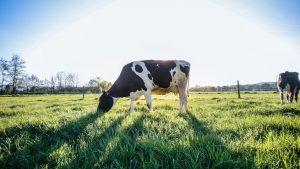
The June Federal order Class III benchmark milk price was announced at $19.87 per hundredweight, up $1.32 from May, $4.96 above June 2023, and the highest Class III price since December 2022.
The six-month Class III average stands at $16.92, down from $17.48 a year ago, and compares to $22.95 in 2022.
The Class IV price is $21.08, up 58 cents from May, $2.82 above a year ago, and the highest Class IV since October 2023. Its six-month average is at $20.17, up from $18.59 a year ago, and compares to $24.67 in 2022.
Churns, vats keep busy
You’ll recall May milk production was down 0.9% from a year ago, but that didn’t have much impact on the May Dairy Products report, according to StoneX broker Dave Kurzawski on the July 8 “Dairy Radio Now” broadcast.
Cheese production climbed to 1.213 billion pounds, up 2.1% from April’s count, which was revised up 1 million pounds, and was up 0.7% from May 2023. Output for the first five months of 2024 totaled 5.97 billion pounds, up 0.6% from 2023.
Wisconsin cheese output totaled 305.6 million pounds, up 3.6% from April and up 3.2% from a year ago.
California produced 214.5 million pounds, up 3.9% from April, but 0.5% below a year ago.
Idaho contributed 81.6 million pounds, down 8.6% from April, but 8.9% above a year ago.
New Mexico, with 81.0 million pounds, was up 3.9% from April, but down 13.5% from a year ago.
Italian cheese totaled 505.1 million pounds, up slightly from April and 4.4% above a year ago. American output climbed to 488.1 million pounds, up 4.5% from April but 5.7% below a year ago. Mozzarella, at 405.1 million pounds, was up 7.1% from 2023.
Cheddar output totaled 329 million pounds, up 11.8 million pounds or 3.7% from April’s level, which was revised down 5.1 million pounds, but was down 35.3 million pounds or 9.7%, from a year ago. YTD Cheddar was at 1.6 billion pounds, down 7.6%.
Kurzawski says Cheddar has been underwhelming all year but pointed to the increase in Mozzarella, saying, “Demand has been really hot.”
He suspects that consumers using home delivery services like Door Dash and Uber Eats are reverting to pizza rather than individual meals because it’s cheaper, and that has increased the draw on Mozzarella cheese.
Yogurt production totaled 403.2 million pounds, up 5.5% from a year ago. Hard ice cream, at 65 million pounds, was up 2.3%.
Dry whey output fell to 76.6 million pounds, down 4.6 million pounds or 5.7% from April, and down 5.2 million or 6.4% from a year ago. YTD whey is at 387.7 million pounds, up 1.5%.
Stocks fell to 64.5 million pounds, down 8.1 million or 11.2% from April and down 13.6 million pounds or 17.5% from a year ago.
Nonfat dry milk output slipped to 171 million pounds, down 3.2 million or 1.8% from April, and down 35.5 million pounds or 17.2% from a year ago. YTD powder was at 814.6 million pounds, down 14.9%.
Stocks continued to slowly grow, climbing to 283.6 million pounds, up 2 million pounds, or 0.7% from April, but down 16.7 million pounds or 5.6% from 2023.
Skim milk powder production jumped to 41.9 million pounds, up 6.1 million pounds or 16.8% from April, but down 4.7 million or 10.1% from a year ago. YTD SMP was at 199.2 million pounds, down 18.5% from 2023.
Strong prices
Cash dairy prices started July strong. The Cheddar blocks closed the holiday shortened week at $1.90 per pound, down a penny, but 50.75 cents above a year ago.
The barrels finished Friday at $1.9025, 2.25 cents higher on the week, and 52.25 cents above a year ago. Sales totaled 5 cars of block and 14 of barrel.
The barrels were up 3.75 cents Monday on a trade but were unchanged Tuesday, holding at $1.94, with 15 loads exchanging hands on the morning.
The holiday threw less of a wrench in Midwest cheesemakers’ plans than was typical, says Dairy Market News. Multiple plants were running a normal five-day workweek while milk availability holds up. Cheesemakers are trying to get ahead of a tightening milkshed in the region which faced hot temperatures and/or heavy rains. Even before the weather conditions, cheesemakers were noting lighter component levels. Cheese demand ranges from steady to strong, says DMN.
Cheese production is steady in the West. Milk demand from cheesemakers is stronger, however farm level milk output is generally declining in the region. Retail cheese demand is steady to stronger while food service is steady. Exports are steady to lighter as price competitiveness impacts the situation.
Almost defying gravity, CME butter closed Friday at $3.1325 per pound, up 0.75 cents on the week and 65.25 cents above a year ago, with 3 sales on the week.
The butter inched a quarter-cent lower Monday, with 3 loads exchanging hands, but was up a penny Tuesday on 3 more sales, hitting $3.14, highest since June 4.
Butter churns ran lighter schedules last week. Cream availability was below typical holiday levels and some multiples inched higher, somewhat abnormal in a weekday holiday. Retail butter demand remains ahead of expectations. Some say prices around $3.10 per pound will keep orders in check but “Seasonal butter demand is only expected to push higher moving forward,” says DMN.
Grade A nonfat dry milk finished the week a quarter-cent lower, at $1.18 per pound, 9.25 cents above a year ago, with 6 sales logged in for the short week.
Monday’s powder was up a quarter-cent on 3 trades but gave it back Tuesday, with 5 loads finding new homes, and slipped back to $1.18.
Dry whey ended the week at 49.25 cents per pound, up a quarter-cent, highest since Feb. 26, and 26.50 cents above a year ago, with 2 CME sales on the week.
The whey lost 0.75 cents Monday on a trade but was up a half-cent Tuesday, climbing to 49 cents per pound, on 2 sales.
Pulse offerings rise
Tuesday’s Global Dairy Trade Pulse auction saw 3.86 million pounds of product sold, 100% of the total offered, up from 3.6 million pounds on June 25, and the highest quantity since March 26.
There was 50,706 pounds more instant whole milk powder and 88,184 pounds more regular whole milk powder sold versus the last GDT Pulse auction.
Pricewise, whole milk powder was down 1.6% from the GDT event last week. Skim milk powder was down 0.8% from the event.
You can now read the most important #news on #eDairyNews #Whatsapp channels!!!
🇺🇸 eDairy News INGLÊS: https://whatsapp.com/channel/0029VaKsjzGDTkJyIN6hcP1K






















